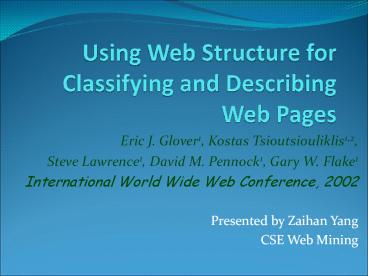Using Web Structure for Classifying and Describing Web Pages - PowerPoint PPT Presentation
Title:
Using Web Structure for Classifying and Describing Web Pages
Description:
Title: Using Web Structure for Classifying and Describing Web Pages Author: Zaihan Yang Last modified by: Brian D. Davison Created Date: 8/16/2006 12:00:00 AM – PowerPoint PPT presentation
Number of Views:28
Avg rating:3.0/5.0
Title: Using Web Structure for Classifying and Describing Web Pages
1
Using Web Structure for Classifying and
Describing Web Pages
- Eric J. Glover1, Kostas Tsioutsiouliklis1,2,
- Steve Lawrence1, David M. Pennock1, Gary W.
Flake1 - International World Wide Web Conference, 2002
- Presented by Zaihan Yang
- CSE Web Mining
2
Introduction
- Aim
- Classification of web pages
- Description of web pages (to name clusters of web
pages) - Using Web Structure
- Extracting patterns from hyperlinks in the web.
- HyperLink
- The destination page
- Associated anchortext describing link
3
- Typical Text-based classification
- To utilize the words (or phrases) of a target
document, considering the most significant
features. - Not Effective.
- E.g.
- The home page of General Motors (www.gm.com)
does not state that they are a car company.
- Full text
- Anchortext
- Extended-anchortext
- A combination
4
Virtual Document
- A virtual document is
- A collection of anchortexts or extended
anchortexts from links pointing to the target
document. - Anchortext
- The words occurring inside of a link
- Extended anchortext
- The set of rendered words occurring up to 25
words before and after an associated link (as
well as the anchortext itself).
5
- Main Method
- Full-text classifier
- Virtual documents classifier
- Two Improvement methods
- Name a cluster
- Main Procedure
6
- Datasets
- Positive a set of web pages downloaded from
various Yahoo! Categories. - Negative Random documents from outside Yahoo!
- WebKB dataset
- Features
- All words and two or three word phrases
- i.e. My favorite game is scrabble.
- Possible features
- My, my favorite, my favorite game, favorite,
favorite game, etc.
7
Dimensionality reduction
- To remove useless features.
- Two step process
- First, remove all features that do not occur in a
specified percentage of documents. - i.e. (Af/A lt T) and (Bf/B lt T-)
- A the set of positive examples.
- B the set of negative examples.
- Af documents in A that contain feature f.
- Bf documents in B that contain feature f.
- T threshold for positive features.
- T- threshold for negative features.
- Second, rank the remaining features based on
expected entropy loss.
8
Expected Entropy Loss
- The prior entropy of the class distribution
- The posterior entropy of the class when the
feature is present - The posterior entropy of the class when the
feature is absent - The expected entropy loss
9
Train SVM
- A set of data points (x1,y1),, (xN,yN)
- xi is an input and yi is a target output (1 or
-1). - Separating hyperplane
- wf(xi) b 0
- wf(xi) b 1 if yi 1
- wf(xi) b -1 if yi -1
- wf(xi) b
- where
- minimizing
- Output
- Kernel function
10
Improvement-Uncertainty Sampling
- The result from an SVM classifier is a real
number from -8 to 8. - When the output is on the interval (-1,1) it is
less certain than if it is on the intervals
(-8,-1) and (1,8). - The region (-1,1) is called
- the uncertain region.
- Uncertainty sampling
- A human judges the
- documents in the
- uncertain region
11
Improvement-Combination
- To combine results from the extended anchortext
based classifier with the less accurate full-text
classifier.
12
Name the Cluster
- Using the top ranked features extracted from the
extended anchotexts virtual documents to name a
cluster. - Beliefs
- The words near the anchortexts are descriptions
of the target documents. - The top ranked features by expected entropy loss
are those which occur in many positive
examples,and few negative ones.
13
Results-classifying
- Anchortext alone is comparable for classification
purpose with the full-text. - Classification accuracy is significantly improved
when using the extended anchortext instead of
the document full-text. - Combination method is highly effective for
improving positive-class accuracy, but reduces
negative class accuracy. - Uncertainty sampling required examining only 8
of the documents on average, while providing an
average positive class accuracy improvement of
almost 10 percentage points.
14
Result--Clustering
- The full-text appears comparable to the extended
anchortext. - The anchortext alone appears to do a poor job of
describing the category.
15
Future Work
- To include other features on the inbound web
pages besides extended anchortext - To examine the effects of the number of inbound
links. - To examine the nature of the category by
expanding this to thousands of categories. - To study the effects of the positive set size.































